The construction of the Mumbai Trans Harbour Sea Link and a proposal to build a replica of Balaji temple on mangrove land will sound the death knell of the fishing community, say activists
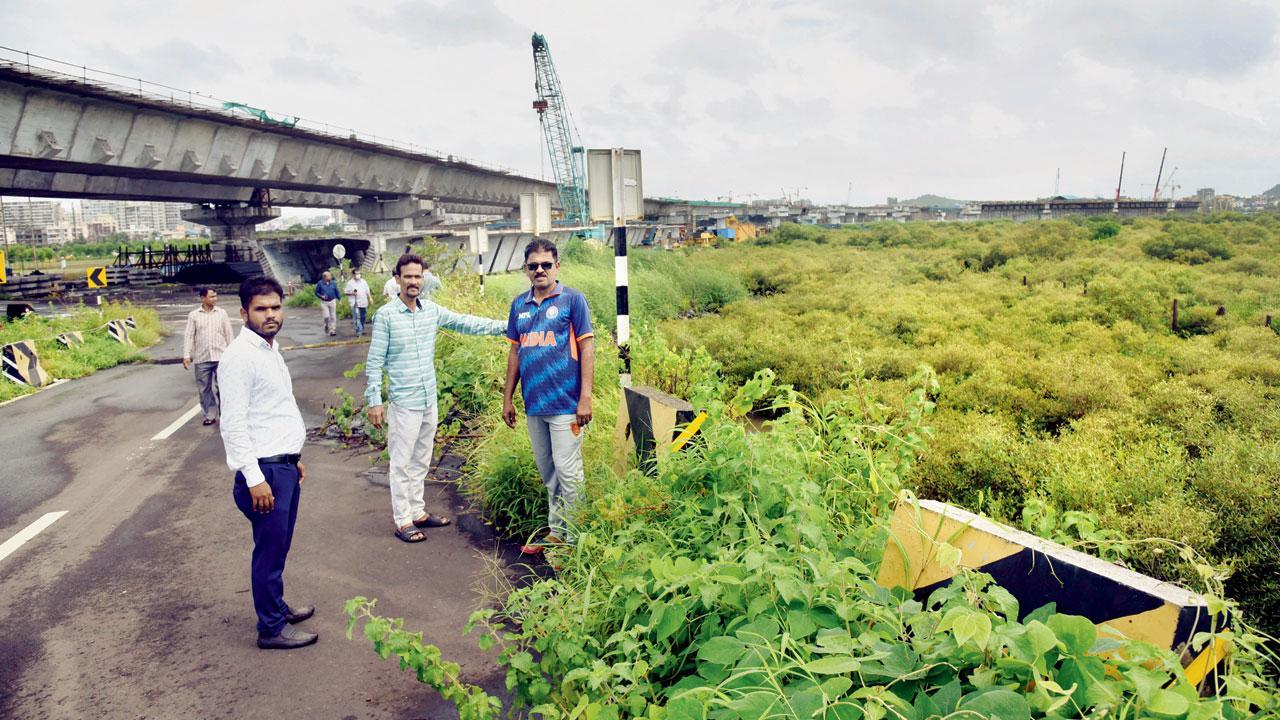
Local fishermen from Gavhan village show mangroves close to the MTHL casting yard
Fisherman Sandeep Koli had been at sea for almost nine hours when we visit him at Gavhan Koliwada in Navi Mumbai. He reached there when the water was still cold at around 5 am, as has been his routine for the past several decades. But even after an arduous work day that ended at 4 pm, Koli had managed to catch less than three dozen crabs. Disappointed, he told us that half of the catch will be set aside for his family, while the other half will be sold at Bhaucha Dhakka. It will fetch him a few hundred bucks only. “The catch has been depleting with every passing day,” he says.
Just about 45 km from Mumbai, on the coastline of Gavhan Koliwada and neighbouring coastal areas in Ulwe and Panvel taluka, the fishermen community is mourning two deaths. That of their livelihood due to the construction of the Mumbai Trans Harbour Sea Link (MTHL), which has affected the marine flora and fauna, and the unceremonious cutting of mangroves and handing over of 10 acres of mangrove land for construction of a Balaji temple.
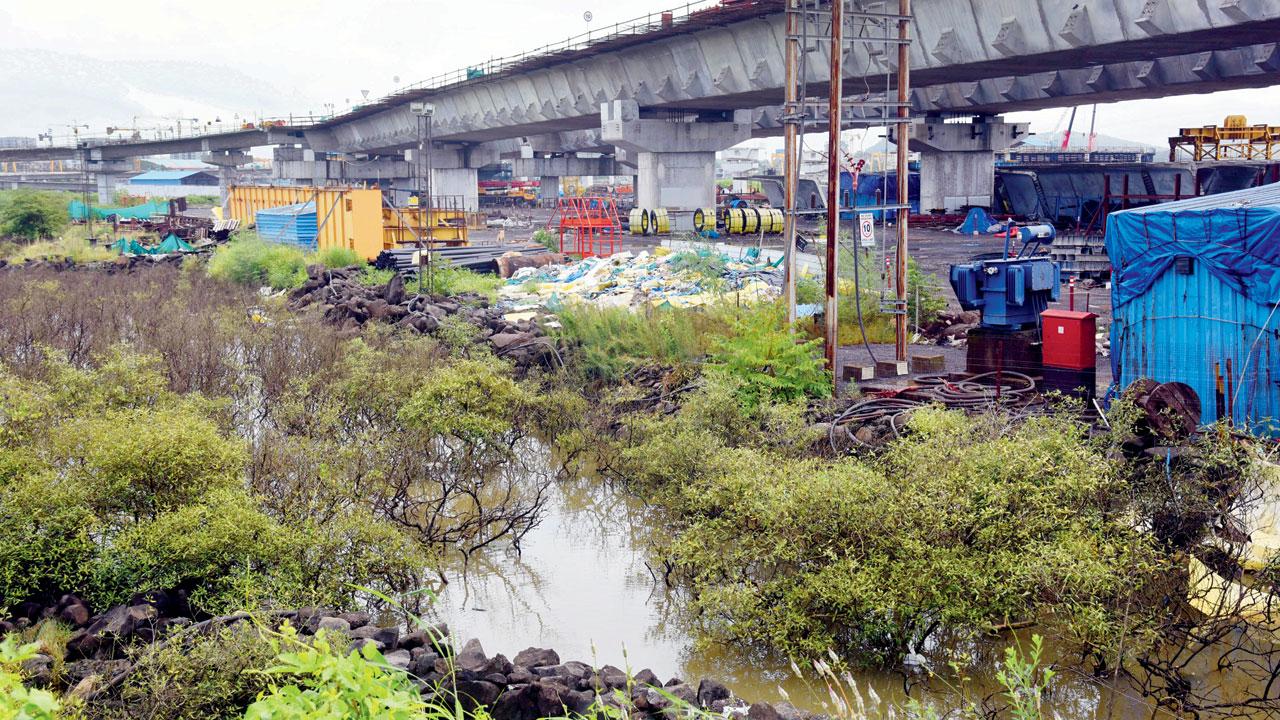
Mangroves visible on both sides of the Mumbai Trans Harbour Sea Link (MTHL), towards Nhava Sheva end at Chirner, Ulwe. With construction work of MTHL nearly complete, local fishermen were hoping that debris would be removed from the site, so that natural tidal waters were allowed to come into the fishing area. That hasn’t happened yet, claim locals. Pics/Sameer Markande
According to locals, construction of the 21.8 km-long MTHL, which is expected to connect Sewri and Nhava Sheva, has set a chain reaction, with many construction projects mushrooming around the coastal stretch. Activist Nandkumar Pawar, 62, who is an environmentalist and Head Coastal Projects of NGO Sagar Shakti, breaks it down for us. “The entire Uran taluka and Panvel taluka are essentially low lying areas surrounded by mangroves, where a number of infrastructure and real estate projects are coming up near the coastal area.”
He explains further, “Mangroves play an important role in protecting the coast as natural barriers against tidal attacks, storms, tsunamis apart from serving as carbon sinks and effective rain forests. They are also breeding grounds for varieties of fish and crabs. Any construction activity is bound to affect the fishing community.”
Also Read: Chain snatchers strike again in Navi Mumbai, target woman on morning walk
Experts say that because the fishing community enjoys no land rights, unlike farmers who get certified as land owners in revenue records, when the sea is encroached, they do not get compensatory benefits. Pawar, who is also a fisherman, visited these areas prior to the commencement of construction activities, witnessing transformation of the coastline across Ulwe, Uran and Panvel taluka nodes first-hand.
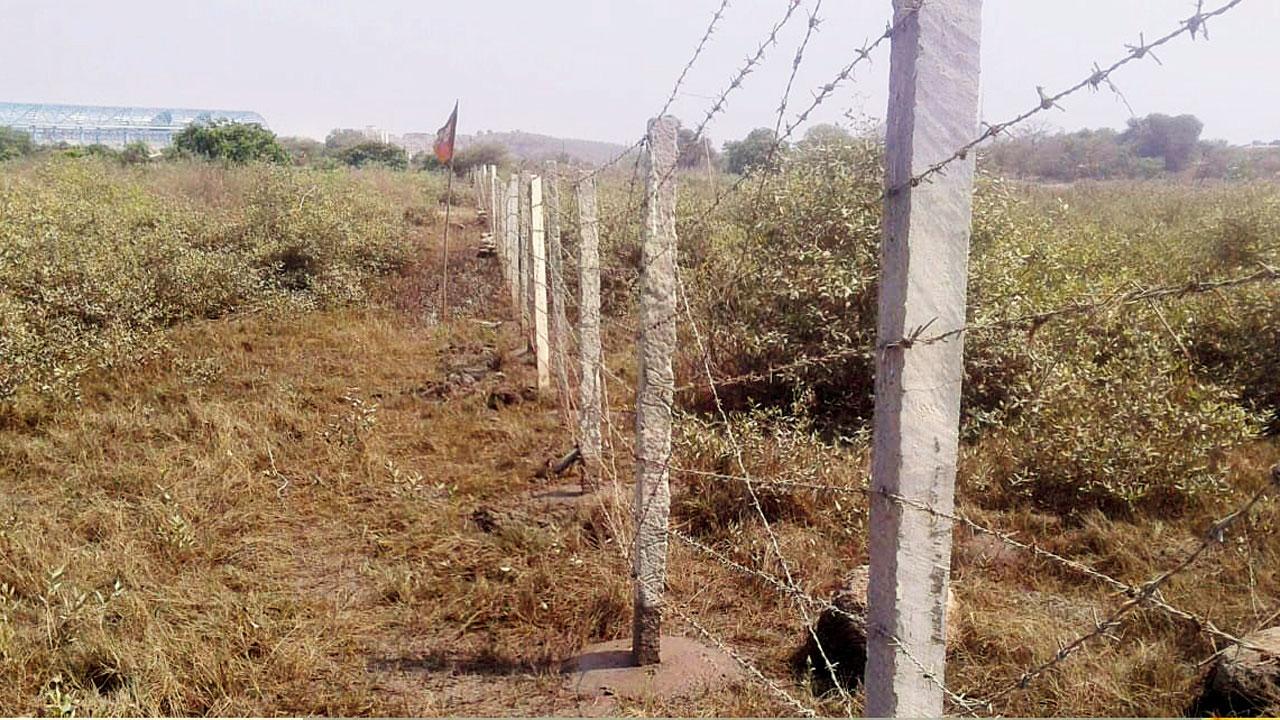
Barbed wires fencing the proposed temple site
The problem started four years ago, when the Mumbai Metropolitan Region Development Authority (MMRDA) took up construction of the MTHL. “The entire construction area has been under tight security since and was kept out of the local fishing community’s reach,” Director of the not-for-profit NatConnect Foundation, BN Kumar says. “With the project nearing completion, they were expecting that the area would be free from all encumbrances, so that they could restart fishing,” he adds.
But, the villagers learnt that 10 acres of mangrove land had been handed over for construction of the replica of Lord Venkateshwara Balaji temple by Tirumala Tirupati Devasthanams (TTD). The Uddhav Thackeray-led Maha Vikas Aghadi government through the City and Industrial Development Corporation (CIDCO) had allotted land to TTD for construction the temple, in April 2022. The registration of the alienated land was done on August 17, 2022, just three days before the scheduled Bhoomi Pujan on August 21. The Bhoomi Pujan was, however, cancelled abruptly.
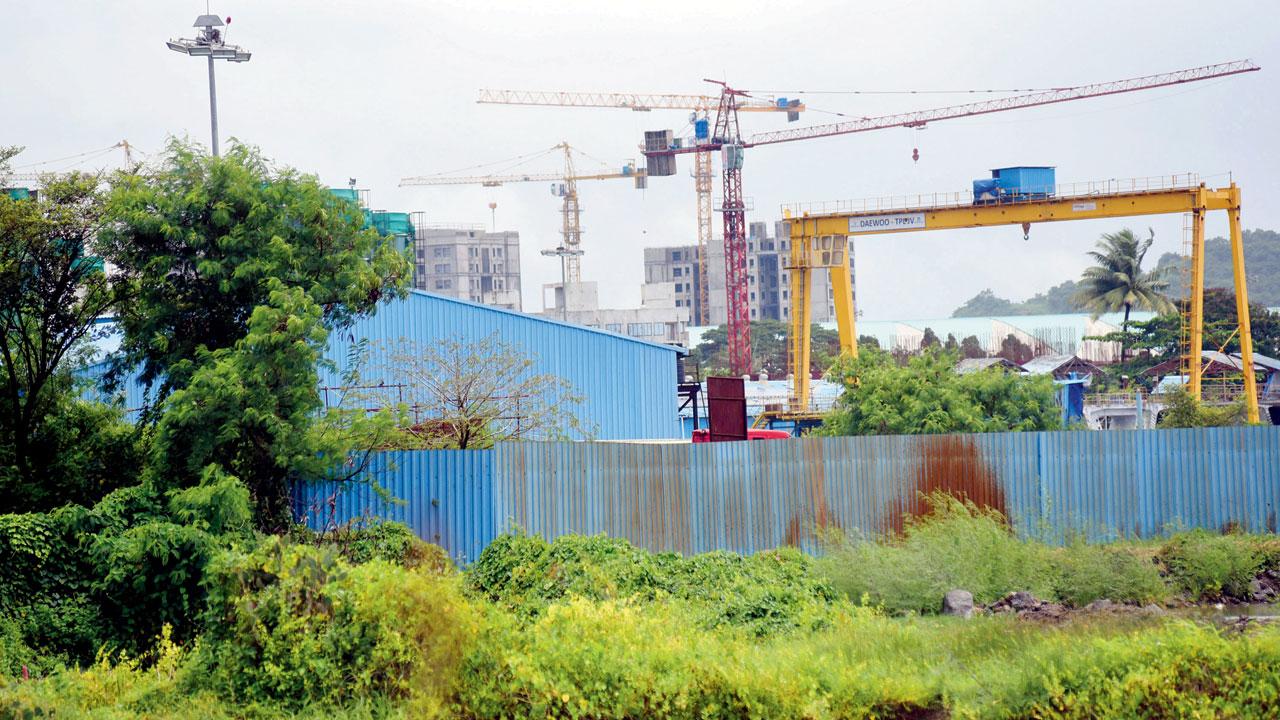
The blue coloured shed that was erected for the proposed Bhoomi Pujan of Balaji temple on August 21, 2022, which was cancelled at the last minute
Mallikarjuna, who is the special officer of TTD’s estate wing tells mid-day, “At the allotted land, MTHL casting work is still underway, but it will end in another two months. Out of the total 10 acres, nearly 60 per cent of the land will be used for construction of the main Balaji temple and temple subsidiaries, which will have a pushkarini (holy pond), priests’ quarters and kitchen for making prasadam etc. The remaining portion of the land will be used for gardening and for growing specific flowers and tulsi, which will be used for daily pooja of the deity.” He adds that the estimated cost of construction for the temple in Ulwe will be between R50-R70 crore, funded by devotees. Construction work will be completed within a year’s time after Bhumi Pujan.”
Mid-day in its article (How did Aaditya hand over mangrove land for a temple?) dated September 13, had stated that green activists would be reaching out to Chief Minister Eknath Shinde to call off the Bhoomi Pujan at the site. “We are not against the temple or its construction, as we believe that God is the creator of the universe, but we need to protect our natural resources. CIDCO or the state government can provide an alternative location for the temple in non-fishing areas and protect the original habitants of the coastline,” says Pawar.

Nandkumar Pawar
The project has also caused damage to many fishermen’s boats anchored on the coast. Inflation and loss of livelihood has added to their fears of taking a loan for a new boat. “A small fibre boat costs around Rs 80,000 and can cross over to somewhere between Rs 3-Rs 4 lakh, which we cannot afford,” said Hitesh Koli, a graduate from the village who works as an autorickshaw driver to make ends meet.
“Fishing was our only occupation. The tidal waters would almost touch our coastline and we would get varieties of fish—tiger prawns, prawns, lobster, king fish (surmai), crabs, Bombay ducks (bombils), etc in large quantities, but after the construction activities started and the ecology of our coastline got affected, most of the fish varieties have vanished,” he adds.
Ecological change has also brought about a change in traditional domestic roles at home. Fisherman Bharat Koli says, “Earlier, our women would stay home, while men would go out for the day’s catch. Today, our women, due to the lack of options, have to work as domestic helps supporting the family by a few thousands of rupees.” He adds, “Unlike older times, even after venturing deep inside the water, the catch is not sufficient enough to feed the family.”
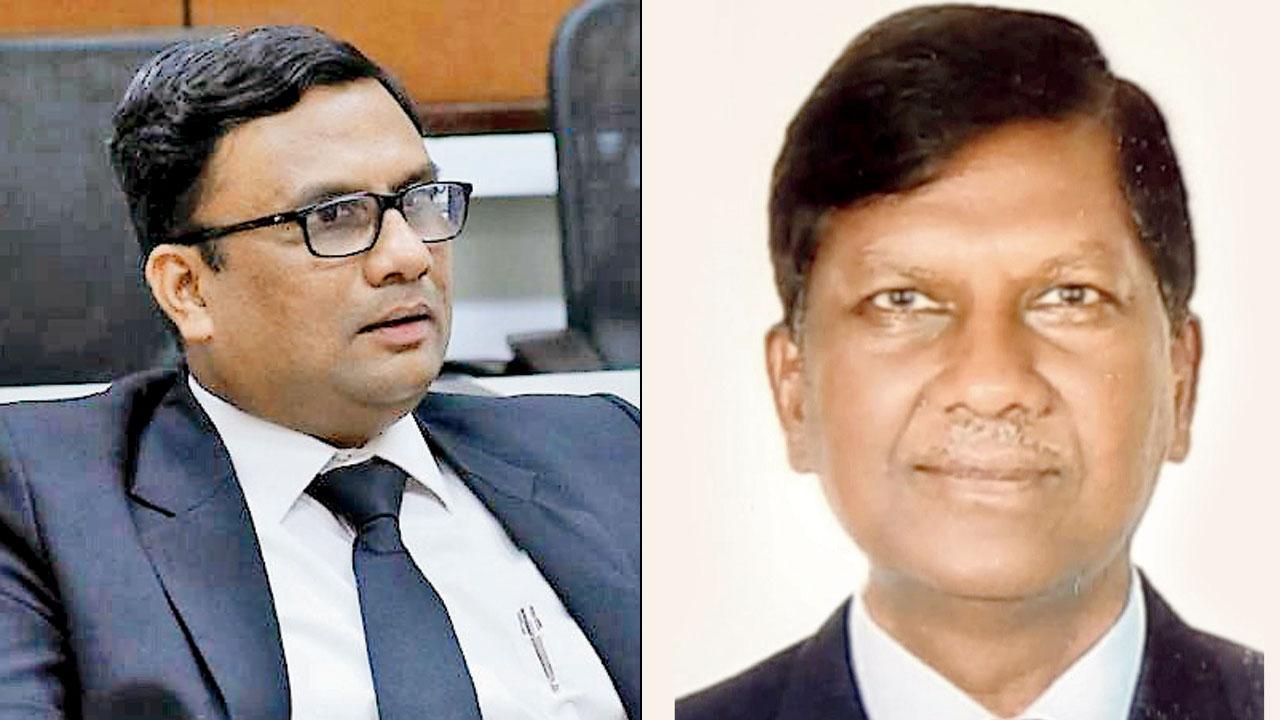
Shreeprasad Parab and Dr Jiyalal Jaiswar
While this reporter and photographer Sameer Markande were at Gavhan Koliwada, an open tempo sans any number plate, laden with dry waste and packing material, illegally dumped its load on the affected land. On spotting the camera, the driver drove away. Fishermen say this illegal activity has become the order of the day and that the origin of these dumpsters is unknown to the community.
Pawar, however, knew the functioning a little too well. “This is the modus operandi adopted by land grabbers and encroachers, who start with dumping waste on coastal land and then suddenly stake claim as rightful owners. Such activities cannot happen without the knowhow of local administration and political connections.”
Pawar says the proposed 10 acres of land allotted to TTD is also regulated within the CRZ-1 norms. These norms protect areas along the 7,500 km stretch of the Indian coastline from development of buildings, tourism facilities and other infrastructure. “The shed erected for the Bhoomi Pujan [still extant] is on the coastline and within the mangrove area. After these constructions, we fear that this area, along with the remainder belt along MTHL might be declared as CRZ-2.” CRZ-2 zone constitutes of areas developed up to the shoreline which fall within the existing municipal limits.
Meanwhile, the Union Ministry of Environment, Forest and Climate Control (MOEFCC) has responded to a complaint filed by NGOs Sagar Shakti and NatConnect Foundation asking the Maharashtra Coastal Zone Management Authority (MCZMA) to probe further. Kumar says, “Dr H Kharkwal, Scientist ‘E’ (CRZ) at MOEFCC, asked the Environment Principal Secretary Manisha Patankar and MCZMA member secretary Narendra Toke to ‘examine the nature and extent of alleged representations in respect of all issues,’ while also asking for action as per law if grievances are found to be true.” Kumar believes the way forward should be restoration of occupied coastlines, rather than encroachment of more such lands. “When we are flooded with international research reports which say that rising sea levels would drown the coasts, these kinds of coastal projects on mangrove zones shouldn’t be given a go ahead.”
‘Fishing is a fundamental right’
Experts speak: Advocate Shreeprasad Parab says that the right to fishing is the customary right of fishermen, which is protected under Articles 13 and 14 of the Indian Constitution. “The Supreme Court has held that the Right to Livelihood is an integral part of Right to Life under Article 21 of the Indian Constitution. Thus, the fishing community has the right to fishing as their fundamental right.” He also added that Article 48A of the Constitution makes it the state’s duty to protect and improve the environment and also safeguard the forests and wildlife of the country. “This includes the coastline and marine animals.” Parab adds, “Article 51A (g) of the Constitution puts the onus of duty on all Indians to protect and improve the natural environment including forest, lakes, rivers and wildlife and to have compassion for living creatures. So, it’s a shared responsibility of the state and all citizens.”
Former chief scientist at CSIR-National institute of Oceanography, Mumbai and an expert IN marine studies, Dr Jiyalal Jaiswar says that the development of the Sewri-Nhava Sheva link is bound to alter the natural topography of the creeks and estuary, affecting tidal currents. “This alteration may hamper the flow of water resulting in flood during monsoon, associated with high tide. Mangroves protect the shore from erosion and break down the strong tsunami waves. They are also a source of producing nutrients facilitating a nursing and breeding ground for fisheries and other aquatic animals. In addition, mangroves provide ample oxygen and consume carbon dioxide from the atmosphere on a large scale. Being ecologically sensitive and protected under CRZ-1 category, any damage to the mangroves is a violation of CRZ norms.”
 Subscribe today by clicking the link and stay updated with the latest news!" Click here!
Subscribe today by clicking the link and stay updated with the latest news!" Click here!










